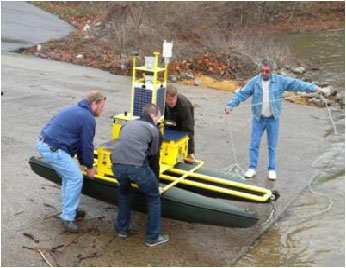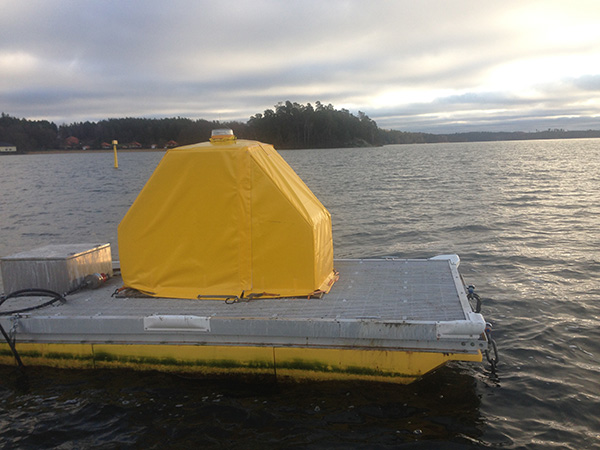Floating Platforms for Continuous Lake Monitoring
Setting up floating platforms for long-term water quality monitoring can be incredibly useful and convenient tools in an organization’s monitoring program.
A lot of times, organizations start out first with a fixed platform. A fixed platform is often the easiest way to start a monitoring program, using a PVC pipe attached to a permanent structure, such as a bridge or pier. A fixed platform also offers secure installation. However, some of the drawbacks to a fixed site are getting permit/site access for mounting instruments, micro-environment or flushing issues, and getting a representative sample.
These tradeoffs often have people turning to a floating platform as an alternative. Floating platforms can be relocated for use in short-term studies, and several styles of platforms can be installed without substantial resources. Floating platforms such as small buoys (EMM68 or DB600) and pontoon platforms (EMM350 PISCES) can be installed using a pick-up truck and small motorboat.
Importantly, floating platforms do not limit your data collection to the shoreline. A moveable platform allows you to sample in a representative location. Built onto the platform can be: water quality sensors; datalogger; a power source (solar panel or lead-acid battery, typically); Hydrosphere data visualization software, and communication systems.
Floating platforms are very popular in dredging applications and coastal construction because of the requirement to frequently relocate the system.
Some of the issues to consider when moving from a fixed platform to a floating system:
- Mooring design
- Depth of water
- Increased power requirements
- Cellular coverage in remote areas
- Limited space for sensors
How to Determine Power Requirements for a Water Monitoring Platform
At a fixed site, a 20-amp hour battery and 20-watt solar panel are generally sufficient for a monitoring site properly oriented towards the equator.
As you move off land, power can become more of an issue as space is limited on the platform, and movement of the platform will reduce the efficiency of a solar panel as it can’t always be optimally aligned toward the sun. It is still most economical to use sealed lead-acid batteries. However, for heavy-draw applications (where you are sampling more than current, met, and water quality), a lithium battery source may be required.

Inland Monitoring with Floating Platforms
Susan Hendricks at the Hancock Biological Station uses both fixed and floating platforms on Kentucky Lake for long-term monitoring to track contributions of nutrients to the lake.
As a floating platform, Hendricks uses a PISCES buoy equipped with:
- Meteorological instruments for air temperature, PAR, precipitation, wind speed and direction, barometric pressure, a GPS unit, and beacon, on top
- 6 small solar panels
- Datalogger and 12-Volt battery in watertight boxes
- YSI water quality sonde in protective sleeve down the center of buoy lowered into the water to a 1-meter depth. The sonde measures water quality parameters: temperature, DO, pH, ORP, specific conductance, turbidity, chlorophyll-a, and phycocyanin.
The buoy has a two-point tether-anchoring system, and cell phone communication for sending data back to the server. There is a CDOM sensor deployed next to the sonde.
Hendricks is satisfied overall with the long-term performance of the monitoring platform.
She notes these challenges to keep in mind:
- Cell phone communication can be expensive
- Need staff dedicated to buoy maintenance, sensor calibration, daily monitoring of sensor performance from the office, and rapid response if something goes wrong (such as vandalism, floods, and even lightning strikes)
Hendricks notes that the advantages of the system include:
- Lightweight
- Ease of transport to remote sites (pick-up truck)
- Ease of deployment from a boat ramp
- Maintenance is relatively easy
- Datalogger can be reprogrammed to accommodate additional sensors as your monitoring program grows or changes

Additional Blog Posts of Interest:
Water Instrumentation Provides Insight for Ecological Research
Top 5 Challenges to Collecting Water Quality Data - Challenge 1
How Does Real-Time Data Save You Time?
Reduce Cost of Water Quality Program with Simple Data Acquisition System